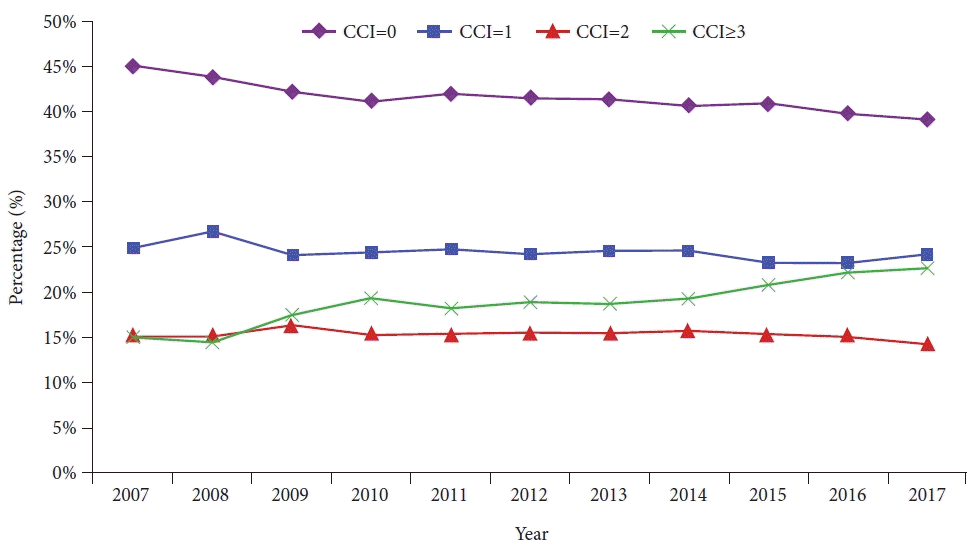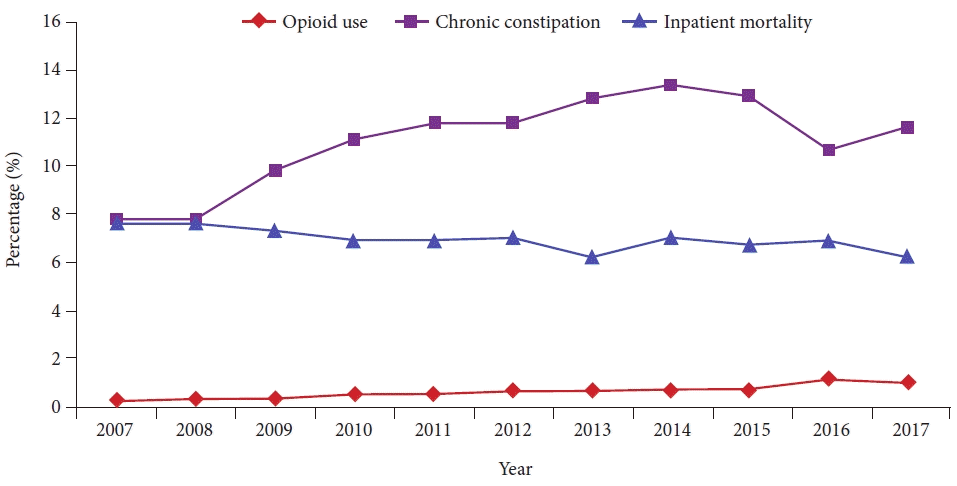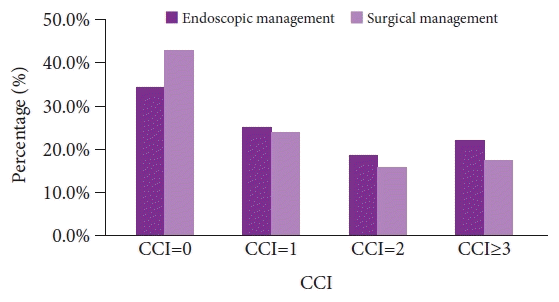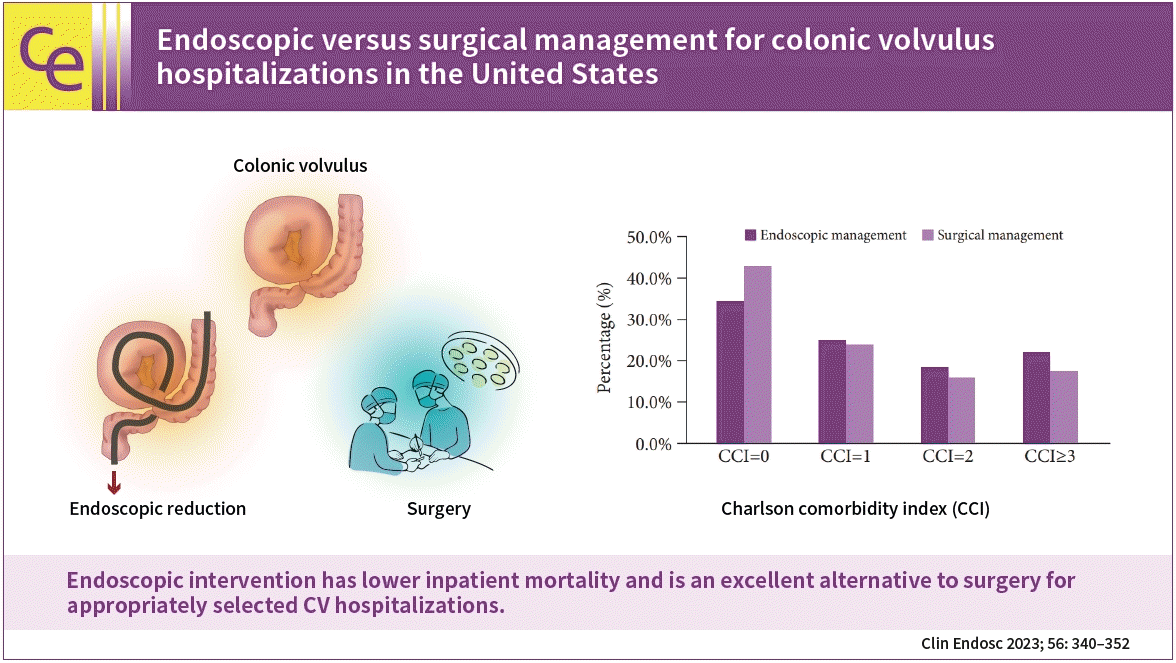INTRODUCTION
Large bowel obstruction is a frequent cause of hospitalization and may occur due to various benign or malignant causes.
1 Colonic volvulus (CV) refers to an axial rotation of a mobile colonic segment along with the vasculature around a fixed base, creating a closed loop mechanical intestinal obstruction.
2 This may further lead to hemodynamic compromise and bowel ischemia, resulting in gangrene formation.
2 The sigmoid colon and cecum are the most common sites of CV.
1 Risk factors for the development of CV include chronic constipation, abdominal surgeries, previous history of volvulus, and megacolon.
3 Additionally, elderly patients, nursing home residents, and those with neuropsychiatric conditions are at increased risk.
4,
5
In the United States (US), CV is the third most common cause of bowel obstruction in colorectal cancer and diverticulitis, accounting for approximately 3.5% of all bowel obstructions.
3,
6 Over the years, the incidence of sigmoid volvulus has remained relatively stable (1.9%); however, the incidence of cecal volvulus continues to increase by 5.53% annually.
7 This rising incidence may be attributed to the increasing medical comorbidities and complexity of patients. Although there is an apparent increase in the incidence of CV, the clinical outcomes of patients with CV in an inpatient setting are largely unknown. Furthermore, in the era of minimally invasive interventions, it is essential to understand the utilization and compare the clinical outcomes of endoscopic and surgical management options for CV. Therefore, our study aimed to identify hospitalization characteristics, comorbidities, and inpatient outcomes for CV hospitalization. We also compared hospitalization characteristics and clinical outcomes of endoscopic and surgical management strategies for CV and identified independent predictors of inpatient mortality for both management strategies.
DISCUSSION
Our study noted a rising trend of CV hospitalizations from 17,888 in 2007 to 21,715 in 2017, with a decline in overall all-cause inpatient mortality. Despite a higher proportion of patients with CCI score ≥1 and associated comorbidities, endoscopic management had lower inpatient mortality, shorter mean LOS, and lower mean THC than surgical management for CV hospitalizations. The identification of trends, associations, clinical outcomes, and a comparative analysis of treatment strategies for CV hospitalizations is essential, as it provides gastroenterologists with real-world data on patients who might be at the highest risk of developing CV and those who may benefit the most from minimally invasive endoscopic interventions compared to conventional surgery.
Previous studies have reported that patients with chronic constipation, opioid users, and older patients are more likely to develop CV compared to the general population.
10-
12 Additionally, there is a higher likelihood of CV in patients with neuropsychiatric disorders.
13 In this study, we observed a rise in CV hospitalizations for patients with chronic constipation from 7.8% in 2007 to 11.6% in 2017 and for opioid users from 0.2% in 2007 to 1% in 2017 (
Fig. 2). A higher proportion of CV hospitalizations for patients with chronic constipation underwent endoscopic intervention than surgical resection (18.7% vs. 11.4%,
p<0.0001). This may, in part, be because the endoscopic detorsion was adequate and successful in these patients. Hence, additional emergent surgical intervention was not warranted. Furthermore, we did not find a statistically significant difference between the endoscopic and surgical management of opioid users. For patients with neuropsychiatric disorders such as Parkinson’s disease and epilepsy, a higher proportion of patients underwent endoscopic intervention than surgical resection (
Table 4). This may have been due to the poor surgical candidacy of patients with neuropsychiatric disorders and an increased risk associated with surgical intervention compared to the minimally invasive nature of endoscopic procedures.
Although patients may undergo endoscopic detorsion for CV, surgical resection is warranted in severe cases to prevent recurrence. Hence, there are more surgical resections compared to non-surgical decompression for CV.
7 Our study echoes these findings as we noted that only 13,745 CV hospitalizations underwent endoscopic management, while 77,157 patients underwent surgical resection. Patients in the surgical cohort were 3.8 years older than those in the endoscopic cohort. This may be due to the recurrent episodes or severe ischemia from bowel obstruction requiring immediate surgical resection which are typically seen in older patients.
14 Interestingly, we noted that a higher proportion of patients ≥80 years old underwent endoscopic intervention compared to surgical resection. This may be because these patients are poor surgical candidates for abdominal surgery and have a high risk of procedural mortality.
15 Furthermore, compared to surgical resection, endoscopic management had lower inpatient mortality (
Table 3), which can be attributed to the invasive nature of surgery and post-surgical complications. However, it is worth noting that we observed lower inpatient mortality rates (7%) for surgical resection compared to other studies in the current literature, which reported mortality rates as high as 15% after the first resection and 9% after recurrent volvulus requiring surgery.
16 This may, in part, be due to standardization and improvement in surgical techniques and increased surgical experience with CV due to the rising hospitalization rates.
Endoscopic therapy for CV may be appropriate in patients with multiple comorbidities despite surgical resection being the traditional practice.
17 However, immediate surgical intervention is warranted if bowel perforation or gangrene is suspected.
17 In our study, a higher proportion of patients with CCI scores ≥1 and associated comorbidities underwent endoscopic intervention, while those with a lower comorbidity burden underwent surgical resection (
Fig. 3). However, the endoscopic cohort had a lower inpatient mortality rate. This finding was in line with the current literature.
18 It suggests that the endoscopic approach may be a better alternative for patients with a high comorbidity burden. After adjusting for confounders, we noted that male sex, increased CCI scores, acute kidney injury, and malnutrition were associated with a higher risk of inpatient mortality in patients undergoing endoscopic intervention for CV; however, the presence of neuropsychiatric disorders was not associated with an increased risk of inpatient mortality in these patients. Furthermore, for surgical management, male sex, increased CCI scores, acute kidney injury, chronic obstructive pulmonary disease, malnutrition, and obesity were associated with a higher risk of inpatient mortality, after adjusting for patient and hospital characteristics.
During the 2007–2017 study period, the mean LOS for CV hospitalizations decreased from 10.2 days in 2007 to 8.8 days in 2017. This may be attributed to improved inpatient management strategies and the widespread availability of endoscopic intervention, which is a less invasive approach for CV. However, the mean THC for CV hospitalization increased from $64,447 in 2007 to $100,928 in 2017. This may, in part, be secondary to the involvement of a multidisciplinary team of specialists and ancillary healthcare professionals in managing complex patients and complications. Moreover, compared with surgical management, the endoscopic intervention cohort had a shorter mean LOS (8.3 vs. 11.8 days, p<0.0001) and lower mean THC ($68,126 vs. $106,703, p<0.0001). This is likely due to faster recovery times and fewer days in the intensive care unit for patients managed with endoscopic interventions.
This study has several strengths and limitations. The study population, derived from a large, multi-ethnic, publicly available database, was a key strength of this study. The NIS database contains information on inpatient hospital stays from hospitals across the US, covering 97% of the US population. Hence, the outcomes derived from this study are applicable and generalizable to hospitalizations in the US. The 11-year study period from 2007 to 2017 allowed us to establish meaningful trends and outcomes, in addition to the current literature. Additionally, through the unique study design, we not only focused on hospitalization characteristics, clinical outcomes, and associations of CV but also compared the differences in endoscopic and surgical management for CV. This allowed for extensive analysis and helped to assess the disease entity thoroughly. Despite its numerous strengths, we acknowledge the limitations of our study. The NIS database does not contain data on the severity of CV, the methods used to establish a diagnosis, or the hospital course. We were unable to assess the impact of pharmacotherapy in the management of CV, which could have impacted the findings of this study. Finally, the NIS is an administrative database that uses ICD codes to store information; hence, the possibility of coding errors cannot be excluded. Despite these limitations, the large sample size, unique methodology, and comprehensive analysis techniques help us to better understand the disease entity. This article aims to stimulate conversations and promote further research on CV.
In conclusion, there was an increase in CV hospitalizations between 2007–2017; however, all-cause inpatient mortality declined. In addition to other risk factors, CV hospitalization for patients with chronic constipation and opioid use has increased. Endoscopic therapy was associated with lower inpatient mortality, LOS, and THC than surgery. In the absence of colonic ischemia or perforations associated with CV, endoscopic therapy may be an excellent alternative to surgery in appropriately selected patients and should be offered as a treatment modality for CV hospitalization.







 PDF
PDF Citation
Citation Print
Print




 XML Download
XML Download